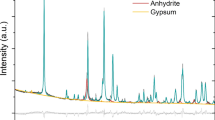Summary.
Calcium sulfate occurs in nature in form of three different minerals distinguished by the degree of hydration: gypsum (CaSO4·2H2O), hemihydrate (CaSO4·0.5H2O) and anhydrite (CaSO4). On the one hand the conversion of these phases into each other takes place in nature and on the other hand it represents the basis of gypsum-based building materials. The present paper reviews available phase diagram and crystallization kinetics information on the formation of calcium sulfate phases, including CaSO4-based double salts and solid solutions.
Uncertainties in the solubility diagram CaSO4–H2O due to slow crystallization kinetics particularly of anhydrite cause uncertainties in the stable branch of crystallization. Despite several attempts to fix the transition temperatures of gypsum–anhydrite and gypsum–hemihydrate by especially designed experiments or thermodynamic data analysis, they still vary within a range from 42–60°C and 80–110°C. Electrolyte solutions decrease the transition temperatures in dependence on water activity.
Dry or wet dehydration of gypsum yields hemihydrates (α-, β-) with different thermal and re-hydration behaviour, the reason of which is still unclear. However, crystal morphology has a strong influence.
Gypsum forms solid solutions by incorporating the ions HPO4 2−, HAsO4 2−, SeO4 2−, CrO4 2−, as well as ion combinations Na+(H2PO4)− and Ln3+(PO4)3−. The channel structure of calcium sulfate hemihydrate allows for more flexible ion substitutions. Its ion substituted phases and certain double salts of calcium sulfate seem to play an important role as intermediates in the conversion kinetics of gypsum into anhydrite or other anhydrous double salts in aqueous solutions. The same is true for the opposite process of anhydrite hydration to gypsum. Knowledge about stability ranges (temperature, composition) of double salts with alkaline and alkaline earth sulfates (esp. Na2SO4, K2SO4, MgSO4, SrSO4) under anhydrous and aqueous conditions is still very incomplete, despite some progress made for the systems Na2SO4–CaSO4 and K2SO4–CaSO4–H2O.
Similar content being viewed by others
Author information
Authors and Affiliations
Additional information
Corresponding author. E-mail: daniela.freyer@chemie.tu-freiberg.de
Received December 17, 2002; accepted January 10, 2003 Published online April 3, 2003
Rights and permissions
About this article
Cite this article
Freyer, D., Voigt, W. Crystallization and Phase Stability of CaSO4 and CaSO4 – Based Salts. Monatshefte für Chemie 134, 693–719 (2003). https://doi.org/10.1007/s00706-003-0590-3
Issue Date:
DOI: https://doi.org/10.1007/s00706-003-0590-3




